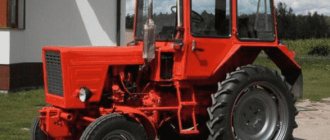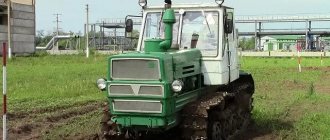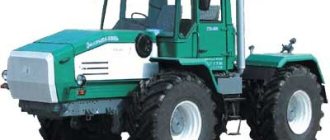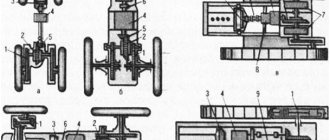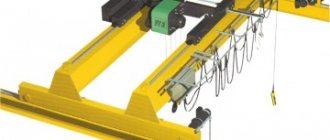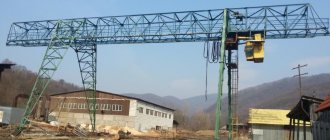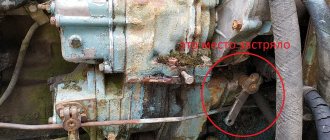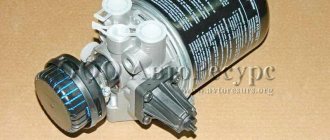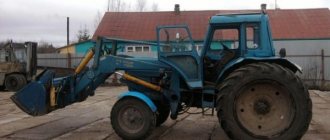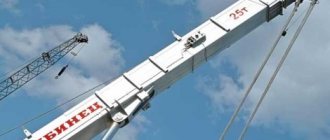There are tractors, the popularity of which among the people is practically not affected by the release of new and more modern agricultural units. These tractors include the legendary T-16, better known to domestic farmers as the “chassis”. It is easy to use and repair with your own hands, versatile, and, importantly, extremely durable - these are the features that our farmers value most in the famous tractor.
The basis, the “heart” of the Chassik T-16 tractor is its D-16 engine. Initially, the T-16 tractors were equipped with engines with a power of 16 hp. s., but later the units were equipped with more powerful engines with an output of 25 hp. With. Tractors with such engines were called T-16M, and their production was extended until 1995.
The engines of the first T-16 units were equipped with simple but very effective air cooling systems. The engines themselves operated in 4 strokes and had 2 cylinders. Additionally, a gas distribution system and a connecting rod mechanism were installed on the tractor engine. A distinctive feature of the first T-16 models was the location of the engines in their design - the engines were located in the rear rather than in the front. To start the engine, each tractor was equipped with an electric starter.
The tractor transmission design included a 7-speed manual gearbox and a dry belt-type brake system. The presence of such a gearbox allowed the tractor to move in a speed range from 1.5 to 17.5 km/h. The transmission was located in the front part of the T-16 tractor structure. All its spare parts are made of durable metal alloys that are highly resistant to wear and corrosion.
The T-16 tractor is equipped with a friction single-disc clutch. It is quite reliable and trouble-free even when operating the tractor in the most severe weather conditions.
The legendary unit has a rigid frame, the surface of which is lined with many reinforcing elements. Later T-16 models were additionally equipped with a roof, panels and doors that protected the driver from precipitation. If necessary, the tractor cabin can be disassembled.
Each Chassik tractor is equipped with a comfortable driver's seat, which can be adjusted according to the weight and height of the driver. For additional comfort, an armrest was provided in the driver's cabin. You can study the interior of the T-16 tractor in more detail in the photo.
To move around the unit, its cabin is equipped with a standard steering wheel and pedals, which are connected to the control levers via fingers and tips.
Special attention should be paid to the presence in the design of the unit of a powerful coupling mechanism, which allows you to install almost any attachment on an agricultural machine.
The simple design of the legendary agricultural machine greatly simplifies its independent repair and maintenance. Due to the availability of free access to the main mechanisms of the unit, its owner did not need to dismantle parts to add oil or replace consumables.
History of the creation of the T-16 tractor
In the mid-50s, production and assembly of DSSh-14 began at the Kharkov Self-Propelled Tractor Chassis Plant. This tractor will be the beginning of a whole line of self-propelled chassis, which will become very popular among the population throughout the former Soviet Union.
— (this is the design of the block in CSS)
DSSh-14 had a design that was original for that time. It was decided to move the engine back, behind the cabin, and install the necessary equipment in front on a tubular frame.
Chassis DSSH-14 with seeder
The first car was released in 1956. Diesel engine with 14 hp. allowed movement at speeds of up to 13.7 km/h, the gearbox had six speeds, and the weight reached 1.67 tons. The tractor was produced in this configuration for 2 years, after which the plant switched to assembling the modernized DVSSH-16. The modernized machine had a weight reduction of 200 kg. weight and increased to 17 km.h. speed.
Further work to improve the self-propelled chassis led to the birth of the new T-16 model in 1961. Here a more powerful 16 hp was used. two-cylinder diesel. With a T-16 tractor weighing 1.43 tons, the load capacity was 750 kg, and the speed increased to 19.5 km/h.
At different times, machines for a wide variety of purposes were produced on the platform of this tractor: excavators, derricks, cranes, vibratory compactors. Equipment for road markings, street cleaning and, of course, a lot of agricultural equipment was installed.
The T-16 itself was produced over a period of six years; a total of 600 thousand were assembled. Modifications of this outstanding tractor were produced until 1995.
Versatile and unpretentious
Many farmers and rural residents recognize that the T-16 tractor is the most versatile and useful of all small power tractors. Unpretentious to use, easy to repair and very reliable, the T-16 tractor has won national recognition and affectionate nicknames - “chassis”, “dasha”, “beggar”, “shaitan”, “waiter”.
At first, the machine was used for work in vegetable growing, spraying trees, and transporting small loads in difficult places. It was also used in small construction teams for transporting stones, sand, wood, winches, sawmills, welding machines, etc. Then it gained popularity in other areas: it began to be used by highways, utility companies and organizations, farmers and rural residents (in an individual household).
Subscribe to our Telegram channel
Technical characteristics of the T-16 tractor
- Engine brand – D16
- Power – 16 hp
- Speed – from 3.72 to 19.5 km/h
- Dimensions length/width/height – 3280/2500/2600 mm.
- The track is adjustable - from 1550 to 2000 mm.
- Weight – 1685 kg.
- The platform's load capacity is 750 kg.
- Agrotechnical clearance – 560 mm.
- PTO – independent 533 rpm.
T-16 tractor engine
D16 is a four-stroke, two-cylinder diesel engine with a power of 16 hp. air cooled. Its peculiarity is the use of a pre-chamber mixture formation method. The prechamber is formed by a cavity that is pressed into the cylinder head in a special insert.
- Engine power – 16 hp.
- Rated speed – 1750 rpm.
- Cylinder diameter/piston stroke – 95/120 mm.
- Fuel consumption – 272 g/kWh
- Cooling is air.
- Towing class – 0.6 t.
The cylinder is cast from cast iron, with cooling fins, 17 in total. High-strength alloy grades of cast iron are used. For precise installation of the cylinders, there is a centering belt on the crankcase.
The material for the manufacture of the cylinder head is gray cast iron. It is attached to the cylinder using four pins. The role of the gasket between the cylinder head and the cylinder is performed by a copper ring.
The pistons are cast from high quality aluminum alloy. To increase the volume of the combustion chamber and improve mixture formation, a recess was made in the piston bottom.
The lubrication system is combined; oil is supplied to the crankshaft crank and main bearings under pressure through special channels; the remaining parts are lubricated by splashing.
The engine is started using a starter, directly from the cab. To make starting easier, a decompressor is installed.
Transmission
The T-16 received an eight-speed (7 forward and 1 reverse) manual transmission. The shafts in the box, relative to the longitudinal axis, have a transverse arrangement. This design made it possible to make it more compact, as well as to use cylindrical gears when transmitting rotation to the differential.
From the power plant, using the bevel gear of the clutch main shaft, torque is transmitted to the gearbox. A special locking mechanism completely eliminates gear shifting when the clutch is not completely disengaged.
The T-16 has a semi-independent power take-off shaft, it is located on the left side of the main gear housing. The shaft rotates at a speed of 533 rpm, at rated engine speed. The PTO is driven by the shaft that drives the clutch.
Chassis and control of the T-16 tractor
The chassis includes a frame, front and rear axles, and wheels. The T-16 frame is used for installing various equipment. This is a rigid welded structure, consisting of two longitudinal pipes, left and right, as well as transverse front and rear bars connecting the pipes.
Two bushings are pressed into the hole in the front beam, which serve as support for the swing axis of the bridge. The front axle itself consists of a balancer and two steering knuckles inserted into it. The rear axle is driven.
The wheels of the driving rear axle consist of a profiled rim, a disc and a low-pressure tire. The racks are evenly distributed and welded along the inner diameter of the rim, to which the disc is attached using six bolts. The wheel is attached to the hub using special bolts that are suitable for both front and rear wheels.
To ensure good adhesion of the tread to the surface, it is necessary to ensure correct installation. The arrow on the tire should point forward in the direction of travel.
Steering
The steering on the T-16 can be either mechanical or power-assisted. The steering column of the tractor is mounted with a flange on the rear beam of the frame. With mechanical control, forces from the steering wheel are transmitted to the front wheels using a system of cardan shafts, gears and sectors.
When steering with hydraulic booster, the force from the steering wheel is transmitted to the dispenser shank, which in turn directs the flow of fluid under pressure from the NSh gear pump into one or another cavity of the hydraulic cylinder. The hydraulic cylinder, in turn, acts on the wheels of the front axle through a swing arm.
Upgraded version of the T-16M
In 1967, the self-propelled chassis was modernized, which received an air-cooled diesel engine with a power of 25 hp.
s., a new gearbox and the designation T-16M, a frame cabin was already installed on it. The T-16M tractor uses a double clutch with combined control. The clutch clutch of a self-propelled chassis has a peculiarity: in it, the linings of the driven disk of the main clutch have a larger area and a larger friction radius than the linings of the driven disk of the PTO drive clutch (power take-off shaft). Therefore, the PTO drive clutch has increased safety functions against the effects of dynamic loads.
The central transmission of the T-16M tractor consists of a cylindrical drive gear mounted on the secondary shaft of the gearbox, and a driven gear pressed onto the differential housing. The differential housing rotates in two bearings mounted in cups installed in the side bores of the transmission housing. The differential of the T-16M self-propelled chassis is a closed type. The locking is performed by a toothed end coupling.
The tractor's final drive consists of single-stage gears mounted in two separate cast housings, which are connected to the rear axle housing through intermediate brake hoses. The main parts of these final drives are interchangeable, with the exception of the crankcase and its stamped pan.
The tractor brakes are simple, band brakes, installed in the sleeves of the differential axle shafts. The semi-frame frame of the T-16M self-propelled chassis is formed by a cast body and a central welded tubular semi-frame. On a self-propelled chassis, the engine and clutch assembly is attached to the main gear housing, and the semi-frame remains open to the dump truck. Due to the use of wheels of increased standard size, the load capacity has increased.
Cabin of the T-16 tractor
On the first models, the T-16 had no cockpit. Later, they began to install a durable frame on the “chassis” to protect the tractor driver from tipping over. Even later, various removable cabin elements were added to the frame: roof, glass panels, doors. Such a cabin already served as protection not only from mechanical influences, but also from bad weather and exhaust gases.
Another advantage was that during the hot season, all quick-release elements were easily removed, leaving only the frame, which was attached to the frame with rubber shock absorbers in six places.
The driver in the T-16 cabin was located on a sprung, single seat, which was adjusted according to the weight and height of the tractor driver.
Hydraulic system and attachments of the T-16 tractor
The machine is equipped with a separate-aggregate hydraulic system designed to control and monitor various hydraulic attachments. The system includes: a hydraulic pump, a hydraulic distributor, an oil expansion tank, oil lines and two hydraulic cylinders.
The equipment used on the T-16 is mounted on a frame in front of the cabin. In agriculture, the machine is perfectly combined with sprayers, equipment for feeding and fertilizing, mowers and hay blowers. It is convenient to hook harrows and rollers onto a bracket, onto the front crossbar, so that the harrow is located between the front and rear wheels.
Various utility equipment can also be perfectly combined with the tractor. Different types of loaders, including a self-loader with a dump truck body. Welding equipment, water pumps, sawmills.
Installation of attachments for a grab loader
The arrow is two-jointed. The main cylinders are located under the boom. The bucket is installed in different types, from mechanical “jaws” designed to grab long objects (tree trunks, etc.), to toothed bowls that close at the bottom, like a double excavator bucket. They are designed for capturing and handling bulk materials.
T-16 grab loader based on the HTZ tractor
This grab loader can work in tandem with dump trucks with a lifting capacity of up to 20 tons. To carry out loading and unloading operations on more powerful trucks, it does not have enough boom reach, since they, as a rule, have a higher side. The productivity is about 50 cubic meters per hour.
The cylinders are equipped with a built-in cleaning system and are therefore resistant to contamination. The lubrication system is built-in. The main maintenance requirements for grab equipment are that the centrifuge and air valves must be cleaned regularly.
Modifications of the T-16 tractor
The T-16 was produced only from 1961 to 1967, all later models are its modifications. Let's look at them in more detail:
T-16M is the first modernization of the chassis. It was distinguished primarily by the installation of a more powerful 25 hp engine. The maximum speed of the car increased to 23 km/h. And the minimum speed for performing work using a creeper was reduced to 1.6 km/h, this significantly expanded the range of agricultural work performed. The weight of the modernized vehicle increased to 1810 degrees. A frame cabin with an awning and doors appeared.
T-16MG - went into production in 1986. Engine power remained the same 25 hp. but in general, the engine has undergone a large number of modifications, thanks to which it began to use its horses more efficiently. The maximum speed of the tractor has increased to 40 km/h. Finally, the tractor received a closed, all-metal cabin and generally became more comfortable for the tractor driver. The tractor had as many as three PTOs, two synchronous and a third independent. The production of this modification was stopped in 1995.
Loader Features
The most famous grab loader with a base at MTZ is called PE-F-1BM and is the base model for a number of modifications.
Design
The machine is used for lifting, loading and transporting work with loads weighing up to 1000 kg. It is based on two MTZ tractors – MTZ-80 and MTZ-82.1.
This versatile loader is equipped with:
- The basic configuration includes a grab and a straight-type bulldozer blade.
- In full set - a grab, a bulldozer blade, claws for collecting hay and silage, and an excavator shovel.
With two working tools, the PE-F-1BM is very compact, that is, it can be used for work in confined spaces in populated areas - for the needs of construction and repair teams and housing and communal services.
Diagram of the PE-F-1BM grab loader
High efficiency and productivity of the MTZ-based grab loader is achieved thanks to the following elements:
- Simplicity of design, facilitating quick operator response.
- Possibility of producing a grab with reinforced bearings for special strength and wear resistance compared to bushings.
- The use of imported hydraulic cylinders.
- Securing the loader to the ground with two support legs during digging and loading.
- Availability of a convenient spare parts box for storing spare parts and service tools.
IMPORTANT! The advantage of this equipment is its unpretentiousness and excellent performance in any climatic conditions.
Operation of the T-16 tractor: reviews from owners
Why did the T-16 tractor gain such popularity among the population? I think the point is in its main advantage, namely, low cost with good reliability and a wide range of work performed.
Other advantages include:
- Easy to operate; a person without any special skills is quite capable of operating the “chassis”. Maintenance and repair are also not difficult if a person, like a mechanic, is at least familiar with the basics.
- Small dimensions allow you to maneuver where a larger tractor cannot turn around.
- Good cross-country ability will allow you to pick up or deliver cargo to places where a regular truck cannot go.
- Due to the low weight, the soil does not roll down much during agricultural work.
- A large selection of attachments makes the machine universal.
The main and almost the only drawback is considered to be the air cooling system of the engine. In winter, it is not possible to start the engine without preheating, and the engine does not have a cold start system.
Let’s read what T-16 owners say about this:
- The technique is excellent, although it has many shortcomings, but you can easily correct them yourself. The tractor is perfect for working with a mower; you don’t need to constantly turn your head - everything is in front of your eyes. Hilling up potatoes is also a pleasure; the hiller, located between the axes, works stably between the rows, everything is controlled visually. Shows itself perfectly in the transportation of goods.
- I will share my impressions of the tractor. My T-16 does not have any additional attachments; I use it exclusively as a truck. And here the vehicle showed its best side; its excellent cross-country ability makes it irreplaceable where a regular truck cannot pass. Ideal for trips to the forest, firewood, mushrooms, pine cones. You can drive into the deepest thicket.
- Personally, I will never purchase such equipment for myself. I consider the disgusting visibility to be a huge disadvantage for myself; if the body is loaded above the sides, then a large dead zone is formed in front. There is also a terrible vibration in the cabin, as if you are riding a jackhammer.
Like any equipment, this tractor has its positive and negative sides.
The advantages of T16 include:
- High cross-country ability;
- Safety for the ground during work;
- Convenient trailer with quick release of contents.
The disadvantages include the following:
- There is no engine cooling installation;
- Difficulty starting the power unit in winter;
- Air filters get clogged quickly. Because of this, they have to be constantly changed;
- During arable work, the front of the tractor is raised;
- The tractor cannot be used for large-scale field work.
tractor T16
Buying a used T-16 tractor: features of choice
The tractor is considered relatively reliable and indestructible, for which it is valued. But when choosing a used tractor, you still need to be careful.
Pay attention first of all to the appearance, how susceptible the car is to corrosion, the presence of smudges on the engine and hydraulic elements. All this will tell you what kind of care was taken for the car, and how kindly the owner treated his workhorse.
Check how the gears shift while driving. There should not be any extraneous noise in the box or crunching noises when switching. Also, tread wear is not unimportant; if the tires require replacement, feel free to lower the price, since buying a new one will cost you a pretty penny.
The price range for the T-16 tractor varies depending on the year and condition of the machine and ranges from 50 to 250 thousand rubles.
Main types of tuning
Creating a universal hydraulic hitch often becomes the main goal for owners of agricultural machinery. Various equipment is attached to it to solve various types of problems: a plow, a seeder, a potato digger, a row cultivator, a hiller.
In this case, tuning the T-16 tractor involves installing home-made equipment on the unit. With this approach, the machine can be used as a front-end loader, tree-strip loader, mounted lift, grab, or excavator.
No less often, tipper or conventional semi-trailers are used to achieve the above goals. To do this, the front drive axle is mounted on the surface of the self-propelled chassis and a mechanical winch is installed. Due to this, the maneuverability of the equipment increases.
